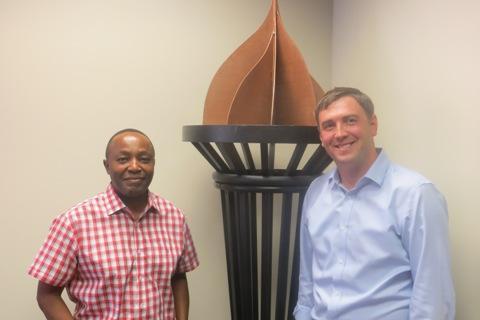The high-tech industry is not known for its diverse workforce. The field is made up of fewer than 25 percent women. At major tech companies in Silicon Valley, the numbers of blacks and Latinos hover between two-and-three percent. The Technology Association of Iowa is hoping to develop ways to attract more minorities to the I-T field.
Tony Kioko is accustomed to walking into a session at a technology conference and seeing no one who looks like him.
“I’ve had several instances where I’m the only African-American in the room,” he says.
Kioko is the assistant director of information technology at Principal Financial Group in Des Moines. He’s leading a committee formed by the Technology Association of Iowa. Its task is to develop ways to draw more minorities to I-T. The president of the association, Brian Waller, says the technology sector of the state’s economy must look toward diversity if it wants to grow.
“When we say diversity, we mean women, we mean minorities, we mean rural Iowans,” he says.
Exact figures for the percentage of women and minorities in technology jobs in Iowa are unavailable. But such Silicon Valley giants as Apple, Google, Microsoft, Facebook and Twitter have come under criticism in recent years for their lack of diversity. The vice president for IT at the Kum & Go convenience store chain in West Des Moines, Joyce Pingel, sees few girls pursuing an interest in the so-called STEM fields. She witnessed it first-hand when her fifth-grade daughter attended a tech-themed summer camp.
“There were two girls there. Hundreds of boys, two girls,” she says. “What’s up with that? It’s already starting at 10- and 11-years old.”
In the 25 years Pingel has worked in information technology, she has seen no increase in the number of women drawn to the industry. She uses her own team at Kum & Go as an example of the absence of gender diversity in IT. It includes just two women. She says she can’t even find females to fill positions.
“I have IT positions that are open in my function, she says. “They’ve been open for four or five months. I’ve had zero resumes from women. Zero.”
Pingel suggests one way to diversify the technology workforce is to make IT classes a requirement in Iowa high schools, not an elective. It was in a New Hampton High classroom where she was first introduced to a computer.
“Growing up on a dairy farm in northeast Iowa with no computers in the home, the only exposure I was ever going to have was in school,” she says.
Pingel says mandatory technology classes would require funding for teachers and laboratories. But she says it would be a solid investment if it leads to a more diverse tech sector.
“When you bring different people together, you get a better, stronger end product than you would if you had like people thinking the same and producing the same end result,” she says.
Pingel believes the interest in technology is present among girls and minorities, it just needs to be tapped through the iPhones and gaming systems they use daily.
Tony Kioko has been reaching out to these young people to encourage them to pursue STEM careers. Three years ago he founded a non-profit program called Tech Journey, aimed at encouraging under-represented youth to enter high tech.
“They just need mentors and the resources to be able to get into the field,” he says.
Kioko counts the initiative a success. Fifty-one students are now enrolled.
“You know, if we can keep them here in Iowa and help them raise the net worth of their families, that’s a great accomplishment for our state,” he says.
Kioko understands diversity within the high-tech community will always be a challenge in Iowa given its overall demographics. But he says getting companies and communities thinking about it is a start.



No Comments